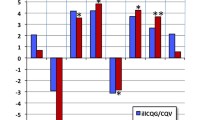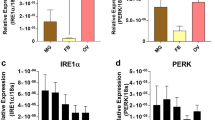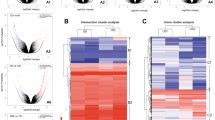Abstract
The ichnovirus TrIV, transmitted by the endoparasitic wasp Tranosema rostrale to its lepidopteran host during oviposition, replicates asymptomatically in wasp ovaries and causes physiological dysfunctions in parasitized caterpillars. The need to identify ichnoviral genes responsible for disturbances induced in lepidopteran hosts has provided the impetus for the sequencing and annotation of ichnovirus genomes, including that of TrIV. In the latter, 86 putative genes were identified, including 35 that could be assigned to recognized ichnoviral gene families. With the aim of assessing the relative importance of each TrIV gene, as inferred from its level of expression, and evaluating the accuracy of the gene predictions made during genome annotation, the present study builds on an earlier qPCR quantification of transcript abundance of TrIV rep ORFs, in both lepidopteran and wasp hosts, extending it to other gene families as well as to a sample of unassigned ORFs. We show that the majority (91%) of putative ORFs assigned to known gene families are expressed in infected larvae, while this proportion is lower (67%) for a sample taken among the remaining ORFs. Selected members of the TrV and rep gene families are shown to be transcribed in infected larvae at much higher levels than genes from any other TrIV gene family, pointing to their likely involvement in host subjugation. In wasp ovaries, the transcriptional profile is dominated by a rep gene and a member of a newly described gene family encoding secreted proteins displaying a novel cysteine motif, which we identified among previously unassigned ORFs.
Similar content being viewed by others
References
Béliveau C, Laforge M, Cusson M, et al. 2000. Expression of a Tranosema rostrale polydnavirus gene in the spruce budworm, Choristoneura fumiferana. J Gen Virol, 81: 1871–1880.
Béliveau C, Levasseur A, Stoltz D, et al. 2003. Three related TrIV genes: comparative sequence analysis, and expression in host larvae and Cf-124T cells. J Insect Physiol, 49: 501–511.
Blissard G W, Smith O P, Summers M D. 1987. Two related viral genes are located on a single superhelical DNA segment of the multipartite Campoletis sonorensis virus genome. Virology, 160: 120–134.
Blissard G W, Theilmann D A, Summers M D. 1989. Segment W of Campoletis sonorensis virus: Expression, gene products, and organization. Virology, 169: 78–89.
Cusson M, Béliveau C, Laforge M, et al. 2001. Hormonal alterations and molecular mechanisms underlying the induction of host developmental arrest by endoparasitic wasps, In: Endocrine Interactions of Parasites and Pathogens. (Edwards J P, Weaver R J, eds). Oxford: BIOS Scientific Publishers, p111–121.
Cui L, Soldevila A, Webb B A. 1998. Expression and hemocyte-targeting of a Campoletis sonorensis polydnavirus cysteine-rich gene in Heliothis virescens larvae. Arch Insect Biochem Physiol, 36: 251–271.
Desjardins C A, Gundersen-Rindal D E, Hostetler J B, et al. 2008. Comparative genomics of mutualistic viruses of Glyptapanteles parasitic wasps. Genome Biol, 9: R183.
Dib-Hajj S D, Webb B A, Summers M D. 1993. Structure and evolutionary implications of a “cysteinerich” Campoletis sonorensis polydnavirus gene family. Proc Natl Acad Sci, USA, 90: 3765–3769.
Doucet D, Cusson M. 1996a. Alteration of developmental rate and growth of Choristoneura fumiferana parasitized by Tranosema rostrale: role of the calyx fluid. Entomol Exp Appl, 81: 21–30.
Doucet D, Cusson M. 1996b. Role of calyx fluid in alterations of immunity in Choristoneura fumiferana larvae parasitized by Tranosema rostrale. Comp Biochem Physiol, 114A: 311–317.
Einerwold J, Jaseja M, Hapner K, et al. 2001. Solution structure of the carboxyl-terminal cysteine-rich domain of the VHv1.1 polydnaviral gene product: comparison with other cysteine knot structural folds. Biochemistry, 40: 14404–14412.
Espagne E, Dupuy D, Huguet E, et al. 2004. Genome sequence of a polydnavirus: insights into symbiotic virus evolution. Science, 306: 286–289.
Fath-Goodin A, Gill T A, Martin S B, et al. 2006. Effect of Campoletis sonorensis ichnovirus cys-motif proteins on Heliothis virescens larval development. J Insect Physiol, 52: 576–585.
Kroemer J A, Webb B A. 2004. Polydnavirus genes and genomes: emerging gene families and new insights into polydnavirus replication. Annu Rev Entomol, 49: 431–456.
Kroemer J A, Webb B A. 2005. Iκβ-related vankyrin genes in the Campoletis sonorensis ichnovirus: temporal and tissue-specific patterns of expression in parasitized Heliothis virescens lepidopteran hosts. Virology, 79: 7617–7628.
Lapointe R, Tanaka K, Barney WE, et al. 2007. Genomic and morphological features of a banchine polydnavirus: a comparison with bracoviruses and ichnoviruses. J Virol, 81: 6491–6501.
Li X, Webb B A. 1994. Apparent functional role for a cysteine-rich polydnavirus protein in suppression of insect cellular immune response. Virology, 68: 7482–7489.
Matz M V. 2000. Amplification of representative cDNA samples from microscopic amounts of invertebrate tissue to search for new genes. In: Green Fluorescent Protein: Applications and Protocols (Hicks BW, ed.). Totowa: Humana Press Inc, NJ, p 1–21.
Rasoolizadeh A, Béliveau C, Stewart D, et al. 2009. Tranosema rostrale ichnovirus repeat element genes display distinct transcriptional patterns in caterpillar and wasp hosts. J Gen Virol, 90: 1505–1514.
Rutledge R G, Stewart D. 2008a. A kinetic-based sigmoidal model for the polymerase chain reaction and its application to high-capacity absolute quantitative real-time PCR. BMC Biotechnol, 8: 47.
Rutledge R G, Stewart D. 2008b. Critical evaluation of methods used to determine amplification efficiency refutes the exponential character of real-time PCR. BMC Mol Biol, 9: 96.
Stoltz D B. 1993. The polydnavirus life cycle. In: Parasites and Pathogens of Insects (Beckage N, Thompson S N, Federici B A,eds), Vol. 1, San Diego: Academic Press, CA, p80–101.
Tanaka K, Lapointe R, Barney W E, et al. 2007. Shared and species-specific features among ichnovirus genomes. Virology, 363: 26–35.
Theilmann D A, Summers M D. 1988. Identification and comparison of Campoletis sonorensis virus transcripts expressed from four genomic segments in the insect hosts Campoletis sonorensis and Heliothis virescens. Virology, 167: 329–341.
Volkoff A N, Béliveau C, Rocher J, et al. 2002. Evidence for a conserved polydnavirus gene family: ichnovirus homologs of the CsIV repeat element genes. Virology, 300: 316–331.
Webb B A, Strand M R, Dickey S E, et al. 2006. Polydnavirus genomes reflect their dual roles as mutualists and pathogens. Virology, 347: 160–174.
Author information
Authors and Affiliations
Corresponding author
Additional information
Her majesty the Queen in right of Canada, represented by the Minister of Natural Resources Exclusive worldwide publication rights in the article have been transferred to Wuhan Institute of Virology, CAS and Springer.
Foundation items: Grants from the Canadian Forest Service (CFS) and a Discovery grant from the Natural Sciences and Engineering Research Council of Canada to MC.
Rights and permissions
About this article
Cite this article
Rasoolizadeh, A., Dallaire, F., Stewart, D. et al. Global transcriptional profile of Tranosema rostrale ichnovirus genes in infected lepidopteran hosts and wasp ovaries. Virol. Sin. 24, 478–492 (2009). https://doi.org/10.1007/s12250-009-3050-3
Received:
Accepted:
Published:
Issue Date:
DOI: https://doi.org/10.1007/s12250-009-3050-3




